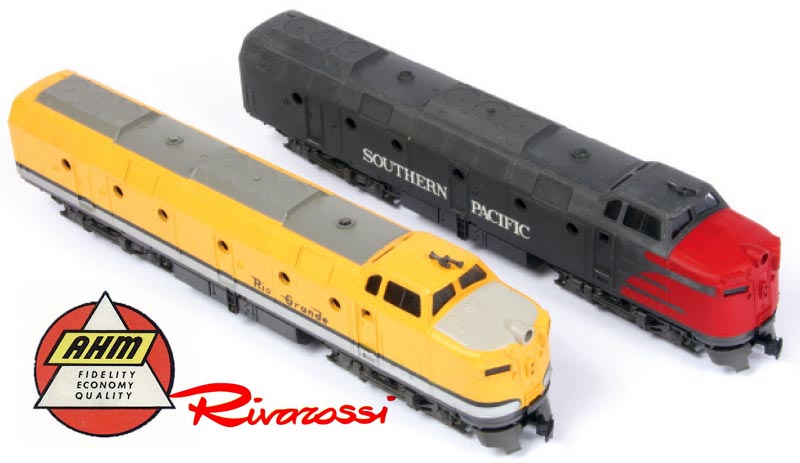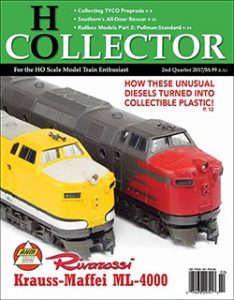For the budding model railroader of the 1970s, the AHM (Associated Hobby Manufacturers) production line was a staple. The company’s large selection of locomotives, rolling stock, and accessories permitted the novice to graduate from the simple HO-scale starter set they received for Christmas one year to becoming a railroad mogul by the next with a well appointed layout for a fairly affordable price. As such, the AHM line-up holds a special place in many of our hearts with certain more memorable offerings, over the decades since, having earned the status of “classic.”
While each of us may have a particular favorite, AHM’s Krauss Maffei (K-M) ML-4000 diesel-hydraulic locomotive certainly resides near the top of the list for many a seasoned hobbyist. It’s often a love-hate relationship, though, as the model offers a bit of variety from the typical U.S. prototype fare and displays a surprisingly good amount of detail for the era, while also being labeled by many as simply downright ugly in form. Nevertheless, the K-M unit is an icon of the old model railroad importer and distributor and worthy of reflection.
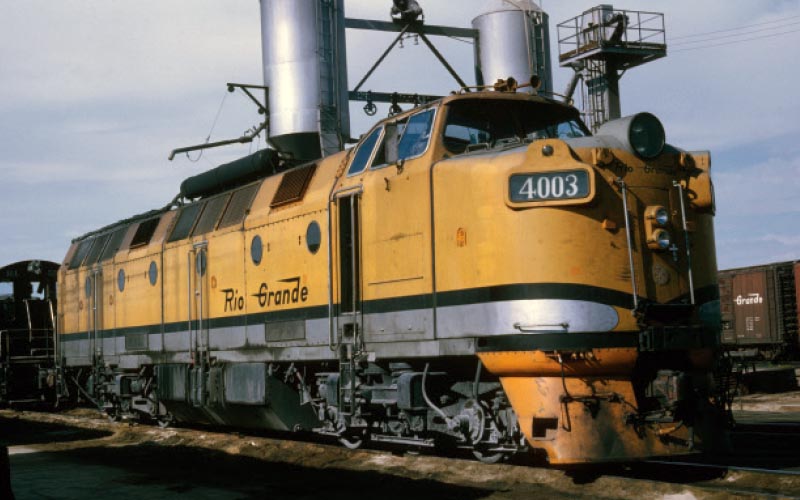
Shots of Krauss-Maffei’s in Rio Grande service are rarer than SP counterparts. Rio Grande didn’t keep its trio more than a year before giving up on the concept. The three D&RGW ML-4000s went on to work for Southern Pacific. Here is a shot of No. 4003 residing at Rio Grande’s Denver-area Burnham Yard. R.R. Wallin photo, Kevin EuDaly collection
German Diesellok on U.S. Rails
For an inexperienced railfan and modeler at the ripe old age of 11, my first contact with AHM’s ungainly looking diesel resulted in a general sense of disbelief that such a beast could have ever roamed U.S. rails. Certainly this model was nothing more than just a repackaging of some sort of European prototype dressed in American garb. It wasn’t until years later, however, after reading Robert Zenk’s article entitled, “The Krauss-Maffei ML 4000 C’C’ Diesel-Hydraulic Cab Units” in the October 1984 issue of Mainline Modeler did I realize my ignorance and a new found respect for this AHM classic developed.
By 1960, many railroads in the U.S., particularly those out west, were finding themselves in a bit of a quandary. Their aging first generation diesel-electrics, some now hitting the 20 year mark, needed replacing, yet the advancements in motive power to date didn’t impress these roads’ motive power managers. Having to deal with harsh climates and rugged terrain, they were looking for higher horsepower per unit as well as improved dependability. Union Pacific, for example, had sidestepped the norm with their introduction of gas turbine electrics to its roster beginning in 1951, which culminated into the 8,500 horsepower Super Turbines delivered in 1958 through 1961.
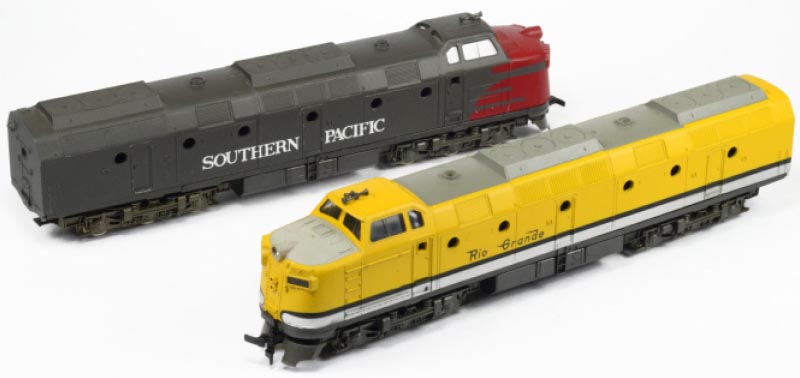
The vast Southern Pacific (SP) and Denver & Rio Grande Western (D&RGW) with its dramatic right-of-way, on the other hand, took a decidedly different approach. Both roads had experienced their fair share of traction motor failures among their vast fleets of F-units and early Geeps and sought out an alternative to the electric power component in these locomotives; the German’s appeared to hold the answer – the diesel-hydraulic locomotive.
When it came to diesel-hydraulic technology, there was really only one company to speak with and that was Krauss-Maffei of West Germany (pronounced “crouse-MOFF-eye” per the magazine article). Either they had built or had at least played a part in the design of pretty much all the diesel-hydraulics then on the rails in Europe and the company was more than happy to meet with prospective customers from across the Atlantic. Having introduced an experimental locomotive in 1958 whereby they rebuilt a single engined 2200 horsepower C-C diesel-hydraulic with two 1500 horsepower V-12 prime movers to produce a 3000 horsepower unit (referred to as the ML-3000), the new locomotive quickly caught the attention of the SP and D&RGW. Both roads would send representatives to the company shortly thereafter to see for themselves the impressive performance of this locomotive as tests were performed throughout Germany and Austria.
In turn, K-M obliged the western roads with a similar design proposal, but sweetened the deal with the option of outfitting the new locomotive with two 16-cylinder 2000 horsepower engines. A single six-axle 4000 horsepower diesel was only a dream in the U.S., as Electro-Motive Division’s closest model at the time, the SD24, could only muster 2400 horsepower, and General Electric’s 2500 horsepower U25C was still a couple of years off. The railroads were intrigued and, in the summer of 1960, SP and D&RGW joined together in ordering six prototype locomotives for further testing.
On Halloween day 1961, the units arrived in the United States and their odd (some railfans might even say scary) appearance, as they were one by one unloaded from the cargo ship at the Port of Houston, Texas, certainly warranted a second glance from bystanders. Outwardly, the designers at K-M had mated U.S. locomotive styling with the operation practicalities of a European diesel. The rounded nose mostly reflected the former’s influence appearing to borrow from the EMD E/F-units or perhaps even more along the lines of Alco’s PA-1, while the raised cab looked to be taken straight from the German double-ended V -200 diesel-hydraulic and the angular long hood behind simply reflected the tight clearances these units’ would encounter during their initial test runs on German/Austrian rails.

In addition, these locomotives have always been described visually as “cab units,” but, unlike American built cab units, such as the EMD F-unit, whose truss-framed carbodies acted as the main structural member, the heavy I-beam chassis and fabricated cross members of these diesel-hydraulic prototypes did the job of carry the load. Their four bolted-on hood sections as well as the cab, which was actually unattached from the frame and rested on rubber cones in an effort to keep the ride and noise level as comfortable as possible for the crew, could be totally removed if necessary. Finally, in regard to appearance, the three-axle trucks also were of European design of welded construction, rather than cast steel sideframes, and beefed up for the rigors of U.S. railroading.
Inside the 65-foot, 11-inch long behemoth were two compact Maybach MD 870 series twin supercharged 4-cycle V-16 diesel engines, each rated at 2000 horsepower at 1,600 revolutions per minute. In turn, each prime mover was connected to a Voith L380 rU Turbo Transmission, located at either end of the locomotive, via large Cardan shafts. Additional Cardan shafts connected the transmission to intermediate gearboxes and then each geared axle.
The ends of the transmissions featured a new device to U.S. railroaders in the form of the hydrodynamic brake, which was basically equivalent to the more familiar diesel-electric’s dynamic brake, but utilized a turbine wheel or “runner” that was connected to the output gearing/shafts and worked against a stationary housing filled with fluid to build up the necessary resistance to slow down the train. The resulting heat that was generated was released through the radiator system. And speaking of the radiator system, cooling was provided by two Behr Company radiator assemblies located in the top of the long hood with each unit equipped with three hydrostatic cooling fans.
Once they arrived on home rails, the ML-4000s were put right to work.
Finished in Aspen Gold-and-aluminum with black striping, Rio Grande’s dieselloks were numbered 4001 – 4003 while the SP’s Dark Lark Gray with Scarlet nose units were numbered 9000 – 9002. The K-M engineers had calculated that the prototypes, each tipping the scales at 165 tons when loaded for service, had a starting tractive effort as high as106,000 pounds with a 78,000 pound continuous tractive effort. This translated into the D&RGW rating its units for 1000 tons on the 3 percent grades found on Tennessee Pass and the SP listing its ML-4000s for 1,725 tons on a 2.2 percent climb.
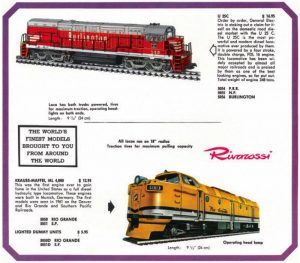 Unfortunately, it wasn’t long before the prototype Hydros, as they were referred to by railfans, began to show their weaknesses. The D&RGW was the first to discover issues with their operation through long mountain tunnels. With their air intakes mounted high up on the carbody, the ML-4000s easily sucked in the hot and polluted air from the leading unit’s exhaust, causing accelerated wear and engine damage. Both roads began a series of test modifications to solve this issue, initially with externally mounted chimneys to take in air at truck level and deliver it up to the old intakes and then later a more permanent fix with the installation of air intakes on the lower car sides and new internal ducting. Reoccurring issues with the main air reservoir location and after-cooling system required adjustments as well. In addition, the multiple-unit connections found on the German locomotives could not fully communicate with U.S. -built diesels and required a conversion to make it possible for the Hydros to mate with EMD F-units, for example.
Unfortunately, it wasn’t long before the prototype Hydros, as they were referred to by railfans, began to show their weaknesses. The D&RGW was the first to discover issues with their operation through long mountain tunnels. With their air intakes mounted high up on the carbody, the ML-4000s easily sucked in the hot and polluted air from the leading unit’s exhaust, causing accelerated wear and engine damage. Both roads began a series of test modifications to solve this issue, initially with externally mounted chimneys to take in air at truck level and deliver it up to the old intakes and then later a more permanent fix with the installation of air intakes on the lower car sides and new internal ducting. Reoccurring issues with the main air reservoir location and after-cooling system required adjustments as well. In addition, the multiple-unit connections found on the German locomotives could not fully communicate with U.S. -built diesels and required a conversion to make it possible for the Hydros to mate with EMD F-units, for example.
Despite these drawbacks, the SP felt it couldn’t make final judgment on the diesel-hydraulic experiment until it had enough units in the field interacting with its diesel-electric fleet on a daily basis and placed an order for 15 production ML-4000s in spring 1962. Delivered two years later, these new units (referred to as “Series” ML-4000s), numbered 9003 – 9017, were essentially the same in specifications as the prototypes, but sported a standard hood configuration with external walkways as well as a more traditional design-cast sideframe three-axle truck. The modifications realized during the trial period were integrated as well. Meanwhile, Rio Grande had shipped off its three cab units to New York Central in the Winter of 1963 for trials on that road where they faired poorly. By the time the diesel-hydraulics were returned, the D&RGW had had enough and in 1964 made a deal with the SP to add the units to its fold.
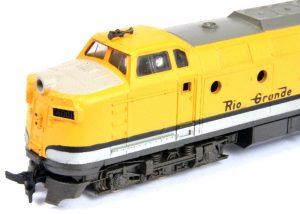
]In the final analysis, perhaps the biggest issue for the railroads overall in regard to the Krauss-Maffei machines were their rigorous maintenance schedule and continuous fine tuning. More so, in 1966, EMD had introduced its new 645 engine series of diesel-electrics, which included the equally powerful 3600 horsepower, more cost effective single engined SD45, putting yet an additional nail in the coffin of the Hydros.
The SP finally realized by now that the writing was on the wall for these costly machines and, one by one, retired the units until the last was out of service by the end of November 1968. Former SP 9010, however, would be saved from scrapping, and rebuilt by the SP into a special unpowered camera car. After its final retirement in 1984, the unit eventually fell into the hands of a restoration group called the Pacific Locomotive Association, who has since restored the unit’s original appearance and is working to make the ML-4000 Series diesel operational once again.


